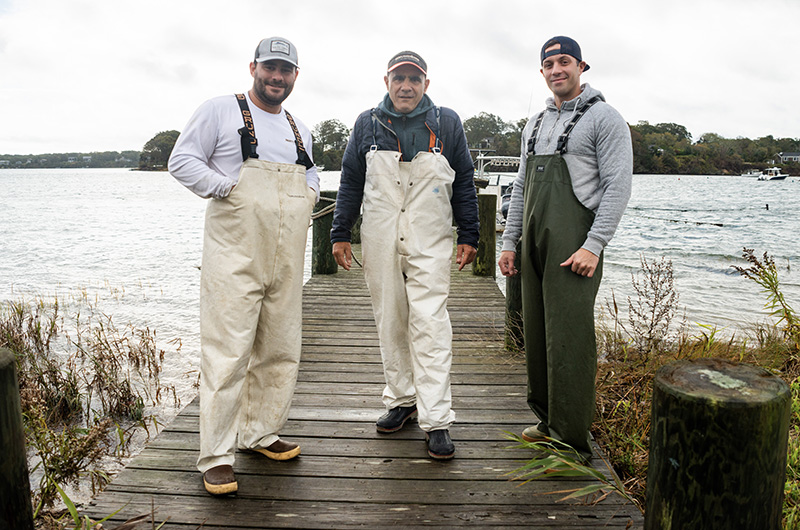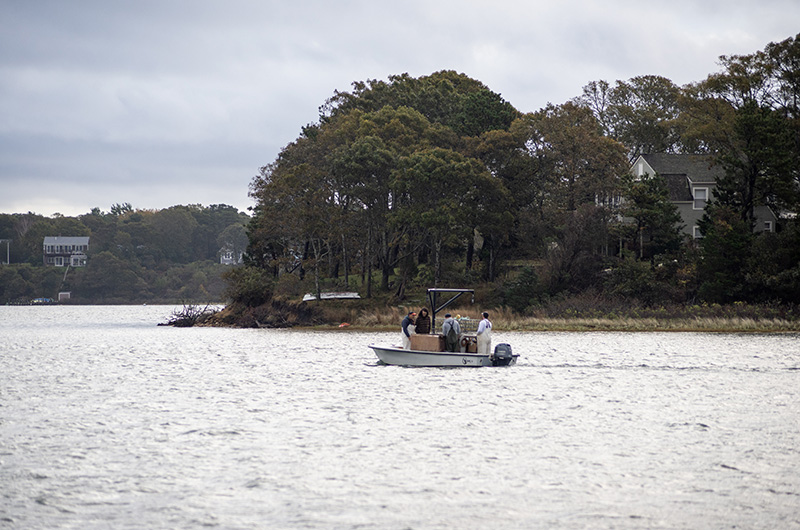Jeff Canha is a fifth-generation Islander who has been on the water since he was born.
“I’ve got Vineyard Haven seawater in my veins,” he said on a recent morning, heading out into the harbor in a small skiff with his son Tony and chef Nathan Gould. For 19 years he ran a fishing charter on his boat Done Deal. During that time his GPS tracked 86,000 miles, just in local waters.
“That’s two trips around the equator,” Jeff said.
These days he isn’t logging as many miles and his quarry has changed. In January 2021 the town approved an aquaculture license for Husselton Head Oysters, whose proprietors are Jeff and Tony Canha. A float on the Vineyard Haven side of the lagoon by the shellfish hatchery is the center of operations for the company. Tony does most of the navigation these days, as Jeff lost much of his vision in the last three years due to a genetic degenerative disease.
“I can’t see my hand,” Jeff said, his fingers spread wide and his arm held straight out in front of him.
But that doesn’t mean Tony could manage their project on his own. In a salt-water environment, tools and equipment constantly fail and Jeff is still a formidable mechanic. He no longer works on airplanes as he did for six years, or teaches automotive and marine mechanics at the regional high school, as he did for 13 years, but, he said, “You’d be surprised what I can do by feel.”
Tony nodded in agreement as he snapped bags closed with hog rings.
For Jeff, the switch from charter fishing to shellfish aquaculture is the fulfillment of a lifelong dream.
“I’ve always wanted to do this,” he said. “Growing oysters, you’re cleaning the water, you’re making the ecosystem more resilient, and you’re feeding people.”
In addition to oysters and scallops, the raised cages were filled with baby mummichogs, monkfish and black sea bass nestled between rows, like kids playing hide-and-seek. The quality and beauty of the food the Canhas are growing is remarkable. Jeff opened an oyster so Chef Gould could examine it. The cup was deep. The lip was smooth, not flaky, the meat sweet and mild. The underside of the clean white shell was flecked with purple streaks.
“Just the minerals in the area,” Chef Gould said. “It’s a pretty shell.”
Oystering requires multiple years of investments in time, resources and regular hard labor before there is anything to sell. Both oyster and scallop crops have to be tended closely. Oysters in racks must be regularly tumbled so their shells grow evenly around the edges. The Canhas load them, bag by bag, into a little cement mixer they keep in the middle of their float.
Scallops can injure one another if they get too crowded. They also must be kept free of barnacles. In the racks pulled up, young scallops were almost perfectly clean, but the marks of barnacles that had been scraped off covered their shells.
“There were a lot of barnacles this year,” Tony said, lovingly replacing bags in their racks and lowering them into the water.
On the ride back, bouncing in the bow of the skiff as Tony drove, Jeff looked at home on the water.
“We’re going do two more acres here in the Lagoon,” he said. “And another acre out by West Chop, at Husselton Head. That’s where we get the name.”









Comments (4)
Comments
Comment policy »